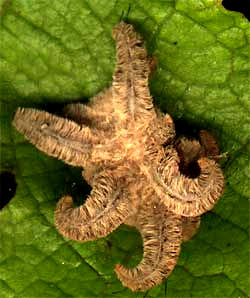Excerpts from Jim Conrad's
Naturalist Newsletter
from the August 29, 2004 Newsletter, from near Natchez, Mississippi
OCTOPUS IN A CUP
For the second time this year my evening was interrupted by a pickup-truck's horn and once again it was my neighbor Karen, this time with hubby Jack, and once again she was holding something in a container she just couldn't wait to show me.
"It's an octopus!" she cried, and when I held the MacDonald's Coke cup with the thing in it up to the truck's headlights and looked inside I had to agree that it looked just like a thumbnail-size, brown, fuzzy octopus with curled, stubby, tentacles. "It was sticking to the side of the truck and we just had to bring it out here!"
 You can see the exact little critter at the right.
You can see the exact little critter at the right.
This time Karen's discovery really stumped me at first. But then I remembered to look at nature systematically, so I set about analyzing the thing as if my mind were an identification key. I pried the creature loose from the cup's wall and saw that beneath its "tentacles" there arose little legs and a head just like a caterpillar's. Therefore, the "tentacles" were just distracting lobes of flesh atop a caterpillar's back.
It was a member of the butterfly/moth order, for that's where true caterpillars occur. So, which family of butterfly or moth was it? Well, noting the caterpillar's sharp, stiff hairs, the sluggish way it moved, and the way its feet stuck to smooth surfaces, the most similar thing I'd seen was the Saddleback Caterpillar I told you about in this year's July 4th Newsletter -- the very species Karen came with the last time!
On the Internet I did a Google image-search using the key word "Limacodidae," which, according to my old Peterson field guide, is the name of the family of the Saddleback Caterpillar. After viewing about a hundred thumbnail photos summoned by Google, finally there it was:
The caterpillar goes by the name of "Monkey Slug," and it's the larva of the very drab-looking Hag Moth, PHOBETRON PITHECIUM. One web site calls the Monkey Slug the "most distinctive caterpillar in eastern North America." I'm not sure it's the most distinctive, but I'd go along with its being the weirdest-looking.
The main thing this identification exercise shows is the incredible tool the Internet has become for backyard naturalists. Monkey Slugs are apparently too rare to be illustrated in any of my books, but Google eventually managed to pull up an image. All I needed was a little help from my dog-eared field guide and an educated guess of the insect's family name.